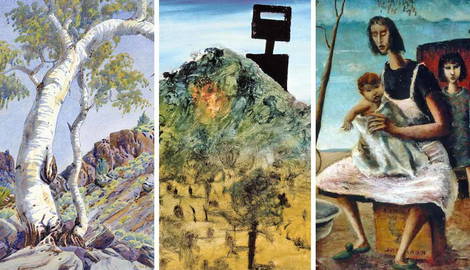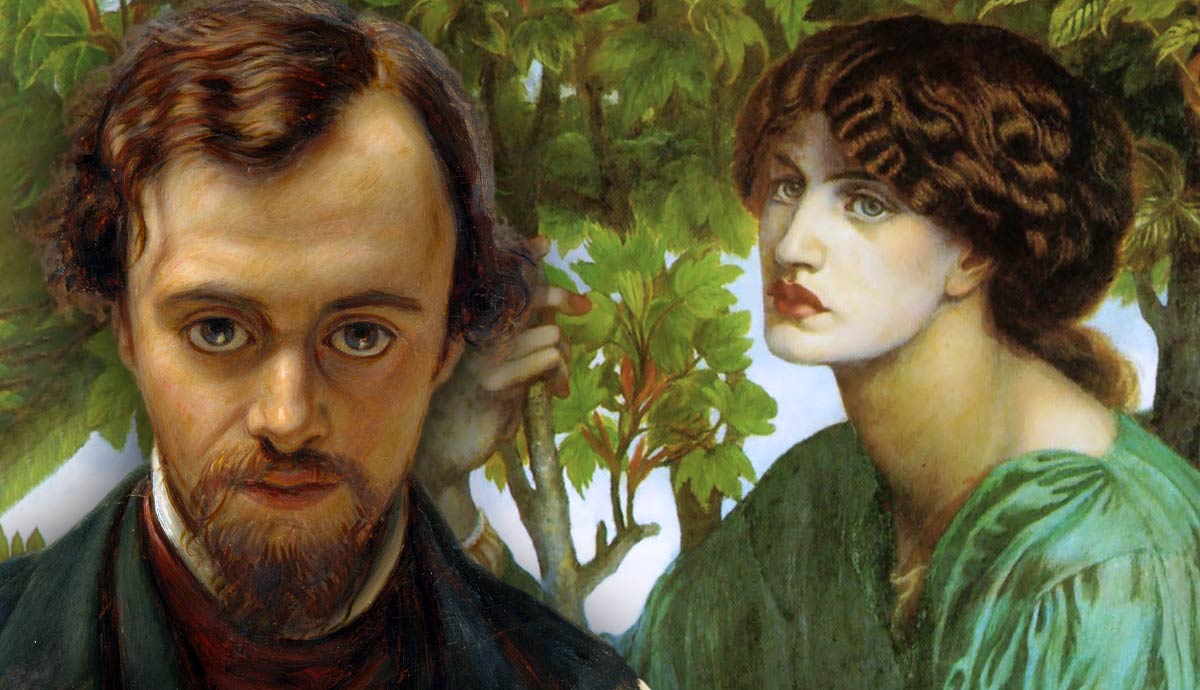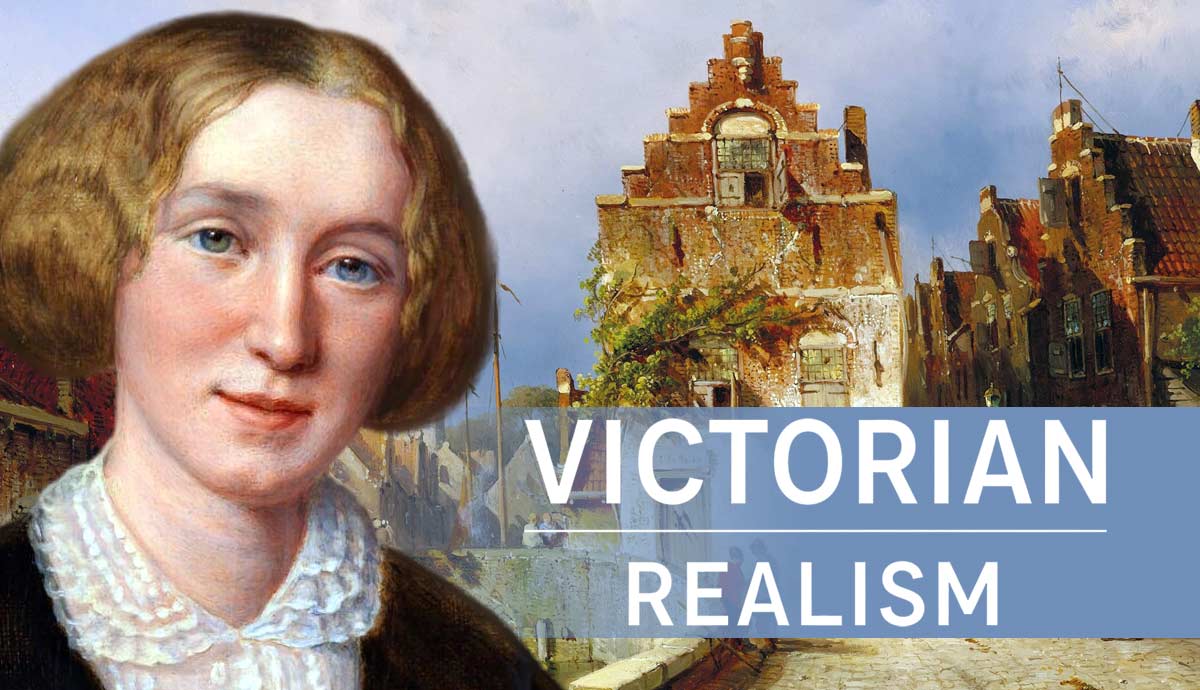
For decades, Australia’s art scene was monolithic; its canon was shaped and dominated by the works of white, male Australian artists that represented what mainstream culture deemed important and acceptable. In the 1960s everything began to change. Aboriginal artists from across the continent started to make their voices heard, proving to the world that they were not a dying race and that their culture was as rich and vibrant as that of non-Indigenous Australians.
While Sidney Nolan’s works take us back to the Colonial Period in Australian history, a time of bushrangers and penal colonies, through the paintings of Aboriginal painter Albert Namatjira we will look at the dire living conditions of Aboriginal people in the 1940s. Finally, Russel Drysdale will introduce us to the harshness of remote Australia.
1. Ned Kelly & Sidney Nolan: Two Iconic Australian Figures

Ned Kelly (1855-1880), Australia’s most beloved bushranger and folk hero, iconic with his bullet-proof homemade helmet and armor suit fashioned from plow moldboards, is the subject of 26 paintings in a series. This body of work, created between 1946 and 1947 and known as the “Ned Kelly series,” established Sidney Nolan (1917-1992) as one of Australia’s most important artists.
Nolan was a young man in his late 20s when he decided to tell Kelly’s story. In Kelly 1946, the bushranger peers out from behind a mountain, dominating the valley below (and Australian consciousness and history, one could argue). Nolan is known for merging Kelly with the Australian landscape (as in Kelly and Sergeant Kennedy and Kelly in Bush). Here, however, his eyes, the only body part of his that Nolan ever shows us in his other paintings, are gone. All we see is the clear sky beyond.

Kelly is his armor; a man who most powerfully encapsulates the contradictions, tensions, and violence of that era. A myth in his own day, in Nolan’s paintings, Kelly is a force of destiny, an authority, self-confident as he rides his horse across the Australian land, his face always hidden behind his iconic bulletproof suit of armor.
In another painting, the claustrophobic Return to Glenrowan, the colors of the tempestuous sky behind Kelly and the tree to his right brush across him and his armor. But who was Ned Kelly, and why did a young painter from post-war Melbourne decide to make him the protagonist of 26 paintings that took him two years to complete?

Ned Kelly was the son of an Irish convict from Country Tipperary charged with stealing pigs and transported to Australia, to the then penal colony of Van Diemen’s Land. After finishing his sentence, John Kelly was arrested several times over the next few years and eventually died of an alcohol-related illness.
An Irish family in a British colony, the Kellys always saw themselves as victims of prejudice and persecution by the Victoria Police. Long before becoming the leader of the notorious Kelly Gang, Ned Kelly himself served several prison terms. He was hanged in the Old Melbourne Gaol at the age of 25, after being captured by the police in the small town of Glenrowan, Victoria, in what is known as the Glenrowan Siege or the Last Stand of the Kelly Gang.

As most myths and cultural icons are, Kelly remains a controversial figure. Some view him as the symbol of Australia’s anti-establishment attitude, as a sort of Australian Robin Hood, standing up for the rights of the underrepresented and the poorest members of 19th-century Australian society. He did, after all, denounce the severe poverty endured by many Irish families in Australia, as well as cases of colonial police corruption, in his 56-page manifesto, now known as the Jerilderie Letter, which he wrote at the age of 24 in 1879.
Others resentfully challenge his legend, stressing his responsibilities in the killing of three policemen and in his slandering of the police force. In making Kelly a reminder of Australia’s past as a penal colony, and the harsh treatment of some of the British Empire’s citizens, Nolan’s series asks us to question our understanding of the past (and the present).
2. Ghost Gum, by Albert Namatjira: The Voice of the Red Center

The Australian landscape is an integral part of Nolan’s art. The same can be said of Aboriginal artist Albert Namatjira (1902-1959). White-trunked gum trees. The yellow sands of creeks’ riverbeds. Pale blue skies. Eucalyptus with long and smooth trunks. Palm-filled gorges, and, of course, the vibrant red rock formations of Tjoritja (also known as West MacDonnell Ranges). This is the multi-faceted region Namatjira has painted all his life, from the 1930s to the 1950s, the country that his ancestors, the Western Arrarnta, had inhabited from time immemorial before the coming of the Europeans.
The country of Albert’s father lay in the MacDonnell Ranges, between Glen Helen Gorge and Mount Sonder (depicted by Albert in one of his most famous paintings), a little more than 130 km (80 miles) west-southwest from Alice Springs. The country of his mother’s ancestors was in the region of Palm Valley (here in one of Albert’s works), 20 km (12 miles) south of Hermannsburg Mission, where Albert was born in 1902.

Roughly 30 years earlier, two Lutheran missionaries from Germany, Hermann Kempe, and Wilhelm F. Schwarz, had settled down at the sacred Aboriginal site of Ntaria with more than 30 horses, cattle, sheep, and chickens, as well as five dogs. Under the silent supervision of Aboriginal people—with whom they had no contact for quite a long time—they built what was to become the Lutheran mission of Hermannsburg, named after the German city of Hermannsburg, where both men had studied.
The case of Hermannsburg is emblematic of the ambivalent role missions have played in the survival of Aboriginal culture and languages throughout the 20th century. As testified by the ground-breaking 1997 Bringing Them Home report, church missions worked with the Australian government in the systematic removal of Aboriginal and Torres Strait Islander children of mixed descent (also referred to as “half-caste,” now a derogatory term) from their families and communities.

In some instances, however, missionaries also actively learned local languages and worked with Aboriginal people to translate the Bible, psalms, prayers, and hymns into their language. Hermannsburg was one of them. While all these efforts were obviously working toward one main goal—that is, to “civilize” Aboriginal people—they also indirectly ensured the survival of many local Aboriginal languages, and their grammar and phonetics prior to contact.
Albert Namatjira grew up in two different cultures. After being baptized and receiving a Western-style upbringing on the mission, at the age of thirteen he went back to his family “on country.” Here he began to learn the culture of his ancestors. His works reflect this racial and cultural divide. At first glance, in fact, Ghost Gum could be mistaken for the work of one of the many white watercolor artists who dominated the Australian art scene in the 1940s and 1950s.

The influence of European pictorial idioms in Namatjira’s works is clear and unmistakable. This made him, among certain circles, the perfect example of the (alleged) success of assimilation policies in Australia.
As a species, the Ghost Gum is known to grow and prosper in inhospitable environments, where other trees would perish. In Ghost Gum, the tree, seen from the base of its trunk, is imposing. It towers over us and the landscape. From this privileged position, the viewer looks from the ground up to the smooth gum trunk, its different shades, the yellow-green leaves on its branches, and eventually to the distant mountain range past the hill in the middle ground. The Ghost Gum is solid, strong, and firmly planted on the ground. It looks like it’s been there forever, from time immemorial.

When Ghost Gum was painted in 1945, Aboriginal people were not officially Australian citizens. They didn’t have the right to vote. They were not allowed to own land or drink alcohol legally. It was only in 1957 that Albert Namatjira and his wife Ilkalita (Rubina) were granted full Australian citizenship, and thus entitled to certain social freedoms.
Such freedoms did not extend, however, to their children. According to Australian laws, Namatjira himself could not purchase the land of his ancestors. Within this framework, Ghost Gum becomes a coded expression of Aboriginal knowledge, the powerful and immortal memory of an ancestral site. It is Namatjira’s assertion of his and his ancestors’ knowledge of the land, as well as a reaffirmation, from within Western sensibility, of Aboriginal existence in this new, colonial world. An aspect of Namatjira’s works most critics have failed to fully comprehend in the 1950s.
3. Sunday Evening, by Russel Drysdale: The Voice of Remote Australia

Russel Drysdale (1912-1981) was born in England to an English mother and an Australian father of Scottish ancestry. His family had owned land on Australian soil for a century. When he was eleven, they moved to Melbourne. Here, Drysdale began to paint.
Drysdale’s Australia is not the sun-drenched peaceful arcadia most painters had depicted up until this point. It is a country of abandoned and dilapidated buildings, a desolate, dried-up land, where men and women wander aimlessly, their skin color matching that of the landscape around them. The protagonists of most of his paintings are rural workers, stockmen, and small-town dwellers with their families. A man feeding his dogs. A woman standing on the veranda of her house, scanning the flat horizon ahead. Four country men waiting outside the local pub, hands on hips. A grandmother walking her two grandchildren on a hot Sunday afternoon.

While very few suburban Australians in the 1920s and 1930s were interested in the conditions of their fellow outback-based Australians, Drysdale was impressed by their stoicism when he visited the hinterlands of Victoria and New South Wales in the 1920s and 1930s. The 1920s and 1930s were years of hardships for Australians, especially for those based in the outback. In the aftermath of World War I, Australia experienced high inflation, which resulted in a severe recession. Then, Black Tuesday happened: On 24 October 1929, the United States stock market crashed, triggering a chain of events that soon affected all industrialized countries across the globe.
A decade later, Australia still hadn’t recovered from the Great Depression. After borrowing vast sums of money from foreign banks, Australia now struggled to repay these debts. In 1932 unemployment levels reached a peak of 32 percent, with more than 60,000 Australians dependent on state-based sustenance relief payment (known as Susso).

National income declined by a third. More and more men (known as “swagmen”) ventured into the outback looking for work. They were pushed by the traveler’s ration card established by the Government to prevent unemployed Australians from living in camps within cities.
In September 1939 World War II broke out. Less than three years later, on 19 February 1942, Japanese forces bombed the city of Darwin in the Northern Territory: this was mainland Australia’s first foreign attack ever. Eleven ships were sunk, and 30 aircraft destroyed in two raids that killed 235 people. Fears of an imminent invasion caused half of Darwin’s civilian population to move out of the city, mostly southward.

Sunday Evening was painted in Sydney, where Drysdale had moved in late 1940, and it perfectly captures the feeling of aimlessness and hopelessness many Australians must have felt during the Great Depression and World War II.
Five figures—a woman, her husband, and their three children—are grouped together to form a static tableau, in which every character looks impassive, absent-minded even, but with their feet steadily planted in the arid land. Their belongings—a bicycle, a tin washing bowl, the kerosene tin on which the woman is seated—seem to grow out of the soil itself. They are thin and elongated figures, silent and stoic, with primitivist mask-like faces reminiscent of Modigliani’s women. They all look lonely.
It is worth noting that Dysdale’s portraits of Aboriginal people evoke a feeling of collected intimacy, of a special closeness that does not exist in his other paintings. As we see in Shopping Day (1953) or Group of Aboriginal People (1953), the Aboriginal people are faceless, strong, and imposing, always painted in tight-knit groups. The family of Sunday Evening seems aware that they’re on the verge of witnessing the worst storm the world has ever seen but determined to ignore it.










